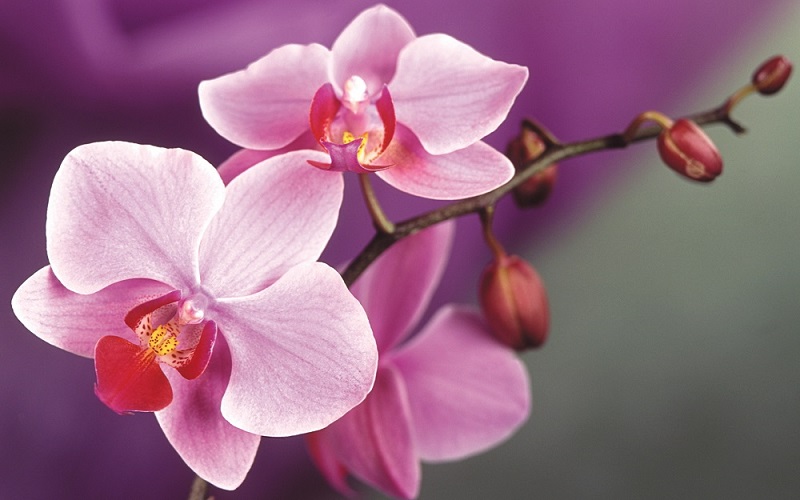Se-tenant: Wild Orchids (strip of 10 from coil) (United States of America 2020)
Wild Orchids (strip of 10 from coil) (United States of America 2020)
21 February (United States of America ) within release Wild Orchids (2020) goes into circulation Se-tenant Wild Orchids (strip of 10 from coil) face value 10*FOREVER No Face Value
| Se-tenant Wild Orchids (strip of 10 from coil) in catalogues | |
|---|---|
| Michel: | Mi: US 5683-5692 |
| Stamp Number: | Sn: US 5444a |
Se-tenant is square format.
Issued in coils of 3000 and 10000 stamps. Stamps will have two opposite sides imperforate. Face value US$0.55 per stamp on day of issueAlso in the issue Wild Orchids (2020):
- Se-tenant - Wild Orchids (Se-tenant Block from Booklet) face value 10*FOREVER;
- Stamp - Three Birds Orchid (Triphora trianthophoros) face value FOREVER;
- Stamp - California Lady's Slipper (Cypripedium californicum) face value FOREVER;
- Stamp - Crested Coral Root (Hexalectris spicata) face value FOREVER;
- Stamp - Showy Lady's Slipper (Cypripedium reginae) face value FOREVER;
- Stamp - Marsh Lady's Tresses (Spiranthes odorata) face value FOREVER;
- Stamp - Eastern Prairie Fringed Orchid (Platanthera leucophaea) face value FOREVER;
- Stamp - Three Birds Orchid (Triphora trianthophoros) face value FOREVER;
- Stamp - Greater Purple Fringed Bog Orchid (Platanthera grandiflora) face value FOREVER;
- Stamp - Yellow Cow Horn Orchid (Cyrtopodium polyphyllum) face value FOREVER;
- Stamp - Tuberous Grass Pink (Calopogon tuberosus) face value FOREVER;
- Se-tenant - Wild Orchids (strip of 10 from coil) face value 10*FOREVER;
- Stamp - Three Birds Orchid (Triphora trianthophoros) face value FOREVER;
- Stamp - California Lady's Slipper (Cypripedium californicum) face value FOREVER;
- Stamp - Crested Coral Root (Hexalectris spicata) face value FOREVER;
- Stamp - Showy Lady's Slipper (Cypripedium reginae) face value FOREVER;
- Stamp - Marsh Lady's Tresses (Spiranthes odorata) face value FOREVER;
- Stamp - Eastern Prairie Fringed Orchid (Platanthera leucophaea) face value FOREVER;
- Stamp - Three Birds Orchid (Triphora trianthophoros) face value FOREVER;
- Stamp - Greater Purple Fringed Bog Orchid (Platanthera grandiflora) face value FOREVER;
- Stamp - Yellow Cow Horn Orchid (Cyrtopodium polyphyllum) face value FOREVER;
- Stamp - Tuberous Grass Pink (Calopogon tuberosus) face value FOREVER;
- Stamp - Three Birds Orchid (Triphora trianthophoros) face value FOREVER;
- Se-tenant - Wild Orchids: Block of 10 face value 10*FOREVER;
- Stamp - Eastern Prairie Fringed Orchid (Platanthera leucophaea) face value FOREVER;
- Stamp - Marsh Lady's Tresses (Spiranthes odorata) PNCB1111 face value FOREVER;
Se-tenant Wild Orchids (strip of 10 from coil) it reflects the thematic directions:
A flower, sometimes known as a bloom or blossom, is the reproductive structure found in plants that are floral (plants of the division Magnoliophyta, also called angiosperms). The biological function of a flower is to effect reproduction, usually by providing a mechanism for the union of sperm with eggs. Flowers may facilitate outcrossing (fusion of sperm and eggs from different individuals in a population) or allow selfing (fusion of sperm and egg from the same flower). Some flowers produce diaspores without fertilization (parthenocarpy). Flowers contain sporangia and are the site where gametophytes develop. Many flowers have evolved to be attractive to animals, so as to cause them to be vectors for the transfer of pollen. After fertilization, the ovary of the flower develops into fruit containing seeds. In addition to facilitating the reproduction of flowering plants, flowers have long been admired and used by humans to beautify their environment, and also as objects of romance, ritual, religion, medicine and as a source of food.
The Orchidaceae are a diverse and widespread family of flowering plants, with blooms that are often colourful and often fragrant, commonly known as the orchid family. Along with the Asteraceae, they are one of the two largest families of flowering plants. The Orchidaceae have about 28,000 currently accepted species, distributed in about 763 genera. The determination of which family is larger is still under debate, because verified data on the members of such enormous families are continually in flux. Regardless, the number of orchid species nearly equals the number of bony fishes and is more than twice the number of bird species, and about four times the number of mammal species. The family also encompasses about 6–11% of all seed plants. The largest genera are Bulbophyllum (2,000 species), Epidendrum (1,500 species), Dendrobium (1,400 species) and Pleurothallis (1,000 species). The family also includes Vanilla (the genus of the vanilla plant), Orchis (type genus), and many commonly cultivated plants such as Phalaenopsis and Cattleya. Moreover, since the introduction of tropical species into cultivation in the 19th century, horticulturists have produced more than 100,000 hybrids and cultivars.
Flora is the plant life occurring in a particular region or time, generally the naturally occurring or indigenous—native plant life. The corresponding term for animal life is fauna. Flora, fauna and other forms of life such as fungi are collectively referred to as biota. Sometimes bacteria and fungi are also referred to as flora, as in the terms gut flora or skin flora.



